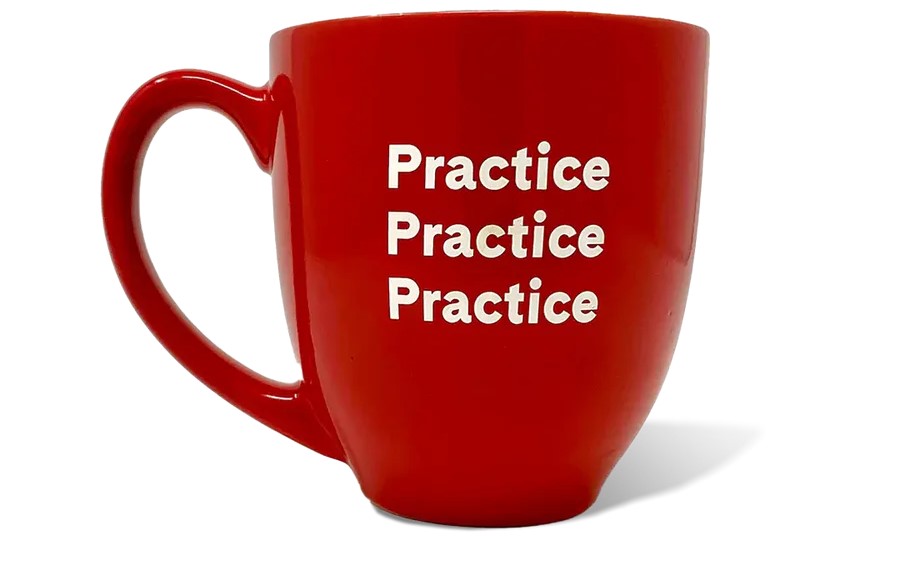Note: This is a bit of a longer post this week. The topic of practice, what it means, what it looks like, etc. is a personal one for me. I’ve played piano for nearly 30 years, and my relationship with practice has evolved from setting an egg timer as a child to carving out moments to be at the piano as a means of self-care in the midst of a busy adult life. This post is admittedly a bit open-ended, but I hope that it provides a window to think about your relationship to practice…
In a recent post, I wrote about the need for some amount of pleasure to aid our persistence in goals. Yet, it seems obvious that we also need some amount of persistence (this is where the 10,000 hour rule hits our intuitive sweet spot: it just sounds right… more time on task leads to more results). Yet, when we hear something like the 10,000 hour rule, it strikes me like the kind of advice students receive to spend 3 hours outside of class for every hour of in-class time. Yet, these instructions very rarely indicate how those hours ought to be spent (the 10,000 hour rule is usually presented in the context of deliberate practice, but then what does deliberate practice look like in this particular instance)?
So, what is practice? As a musician, practice means many things. It’s what I do on a regular basis, it’s both time-on-task and task-oriented behavior. Practice can function as both a verb, something we do, and a noun, something we have. Yet, what does this look like in practice (pun very much intended)? The journey to this perspective takes me back 25 years…
When I was in high school, my then piano teacher gave me an ultimatum: I needed to choose between my longstanding interest in percussion or my longer standing interest in playing piano. She reasoned that the time it took to really practice one (3 to 4 hours a day, everyday) would take away from time and energy for the other. I didn’t question it at the time, and, in spite of my eventual regret at dropping the drums, I pursued piano with a socially sanctioned fervor: I even adjust my high school schedule to be home at 2 so that I could practice until dinner, leaving time for calculus and … not much else (my lack of a social life in high school should be obvious…).
What did those 3 to 4 hours of practice time consist of? I have foggy memories of repeating the pieces I was working on over and over, sometimes with a metronome, sometimes without, and sometimes slowing down when something was particularly tricky or just not working that day. Looking back, I’m sure that this ‘time on task’ contributed to the results I achieved getting into music school, but I’m also sure that it was often boring, at times joyless, and definitely not the kind of practice I learned to engage in later when I reached graduate school. When we operate with heuristics like how much someone should spend, we’re effectively saying “it doesn’t matter how you think/feel/experience that time, just do it.” That I persisted in this regimen could be chalked up to work ethic, but it could also be an unwillingness to call bullshit on what was clearly a suboptimal (let alone unenjoyable) way of working.
In college, not much changed in terms of the ‘just do it’ drudgery of practice, other than that it became a social occasion. Misery loves company! My classmates and I would saunter over to the practice rooms after dinner, stay until way too late, and saunter back to our dorms where we would listen to music and do the things being 18 enables you to do (i.e., staying up way too late and getting up the next morning without needing too much caffeine). It was only as a graduate student that anyone ever broke down what it meant to practice, and I owe my teacher their fair share of credit for opening that up for me. Practice became much more efficient, with much less time needed to achieve the same (if not superior results). As they say: work smarter, not harder.
It was only later, through meditation and yoga classes, that I encountered the idea of ‘having a practice.’ Familiar routines, even challenging ones (I’m looking at you, Ashtanga Yoga), became a welcome place to find some quiet. Practice became a retreat from the day, even while I was working out the small problems of this passage or that technical difficulty. This idea became the basis for my dissertation, exploring how exposure to yoga and meditation might alter our perspectives of having a practice in music. Warming up, settling in, and getting to work have become welcome alternatives to the ‘knowledge work’ and ‘emotional labor’ of my day job. As much as I’d like to believe we can invite students into this approach, I wonder if it might sound a bit esoteric to students who are thinking more transactionally: I do the work necessary to get the grade that is sufficient. Why do I need to learn some mystical routine as well?
As a self-identified creative (whether I am actually creative is up for debate), I enjoy reading the ‘practice’ habits of other creatives. Whether it’s Beethoven counting his 60 coffee beans, or the many authors who set a daily word count, or the amount of illicit stimulants 19th century authors used to full their ‘masterpieces,’ what strikes me is not a formula for success but an ode to the power of rituals in sustaining a creative practice. At a time when we bemoan the attention spans of our students (let alone our own problems with focus), the power of ritual can be a way to gain focus. I’ve spoken to faculty here at PCA&D about their ‘practice:’ do they listen to music? What kind of headspace do they want to really get into their work? I have rituals that help me keep track of time and settle in: I listen to a particular piece of music that lasts one ‘Pomodoro’ (a productivity technique of focusing in 25 minute increments followed by rest periods). I detest alarms, so having a piece of music that ends, suspended in midair, helps me let go of the work.
Just as I was taught to practice, I wonder to what extent we can teach our students to ‘have a practice.’ John Warner’s book, The Writer’s Practice, provides a structured series of exercises that guide aspiring writers (including myself) through the habits of mind that constitute writing intentionally. Yet, I wonder if this is the same thing as encouraging students to honor the ritual of spending time on their artmaking. If practice is only ‘getting things done,’ we get the satisfaction of checking items off our to-do list, and we do end with accomplishments in the long run. At the same time, learning to set aside our practice as its own reward can give us the freedom to use that time creatively: exploratory practice sessions have resulted in unplanned breakthroughs in how I approach the piano. As Degas is credited with saying (but apologies for the gendered language), “Only when he longer knows where he is going does the painter do good things.”
If we want our students to share this view, we may need to open up our practices to them. We may need to consider how we can structure our work to encourage the formation of practice. As much as we want to teach skills, we also want to teach people how to engage in artmaking in ways that allow them to sustain their creative process: to engage in artmaking as self-care and self-exploration (in addition to self-expression). What practice(s) sustain you in your artmaking?
Image source: https://shop.carnegiehall.org/products/bistro-mug-red



